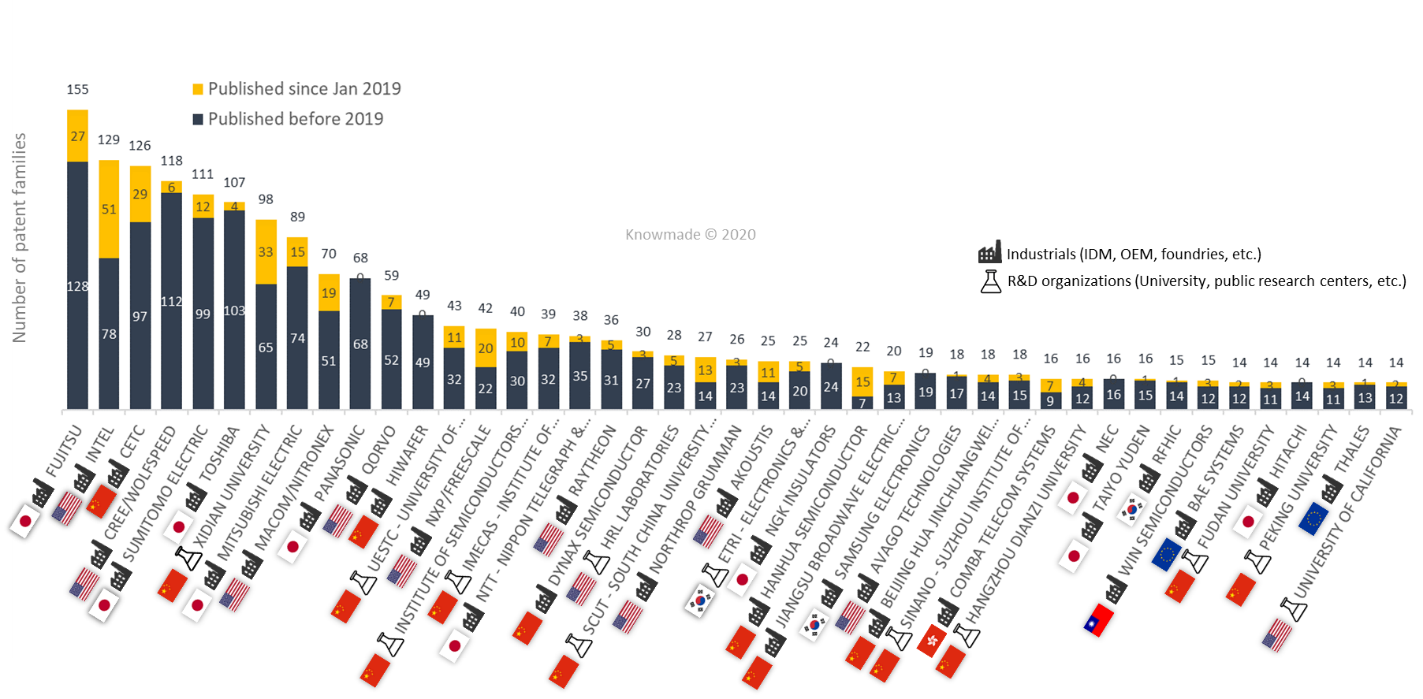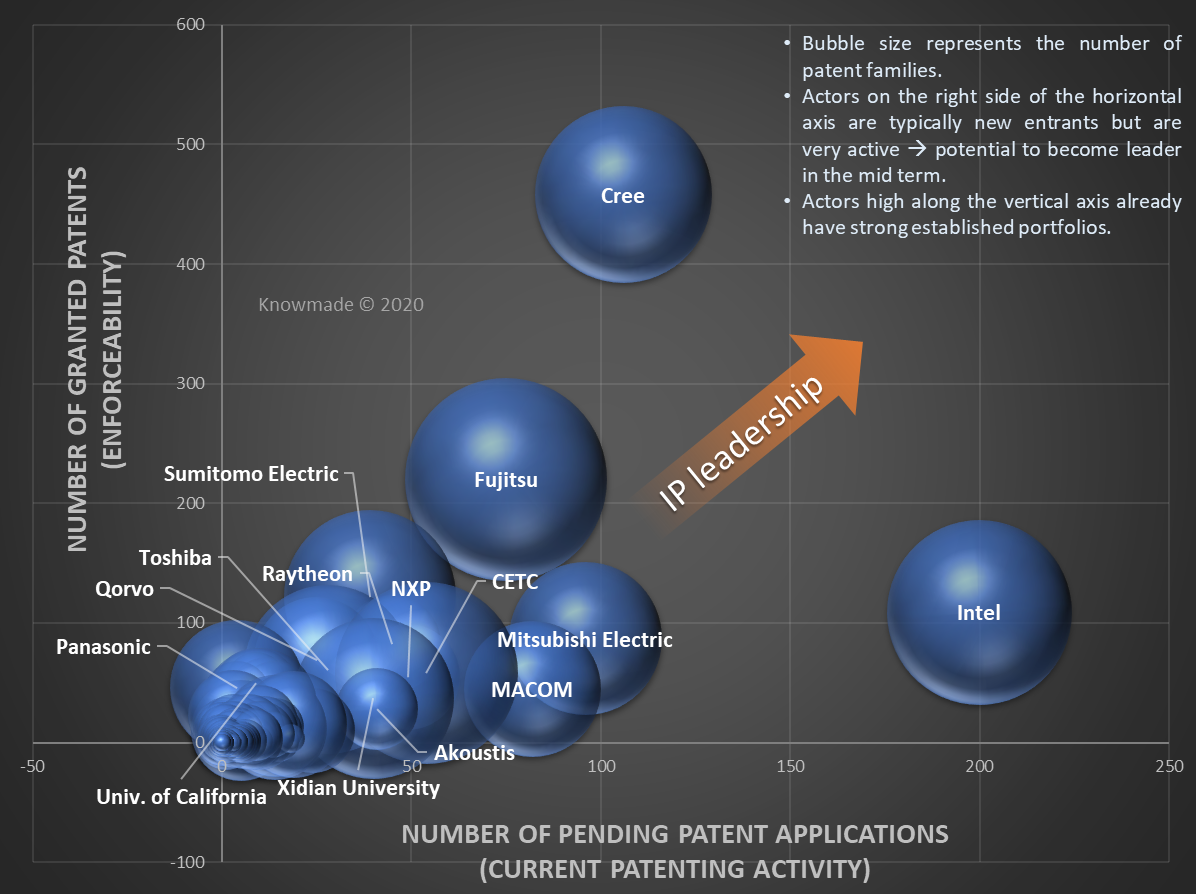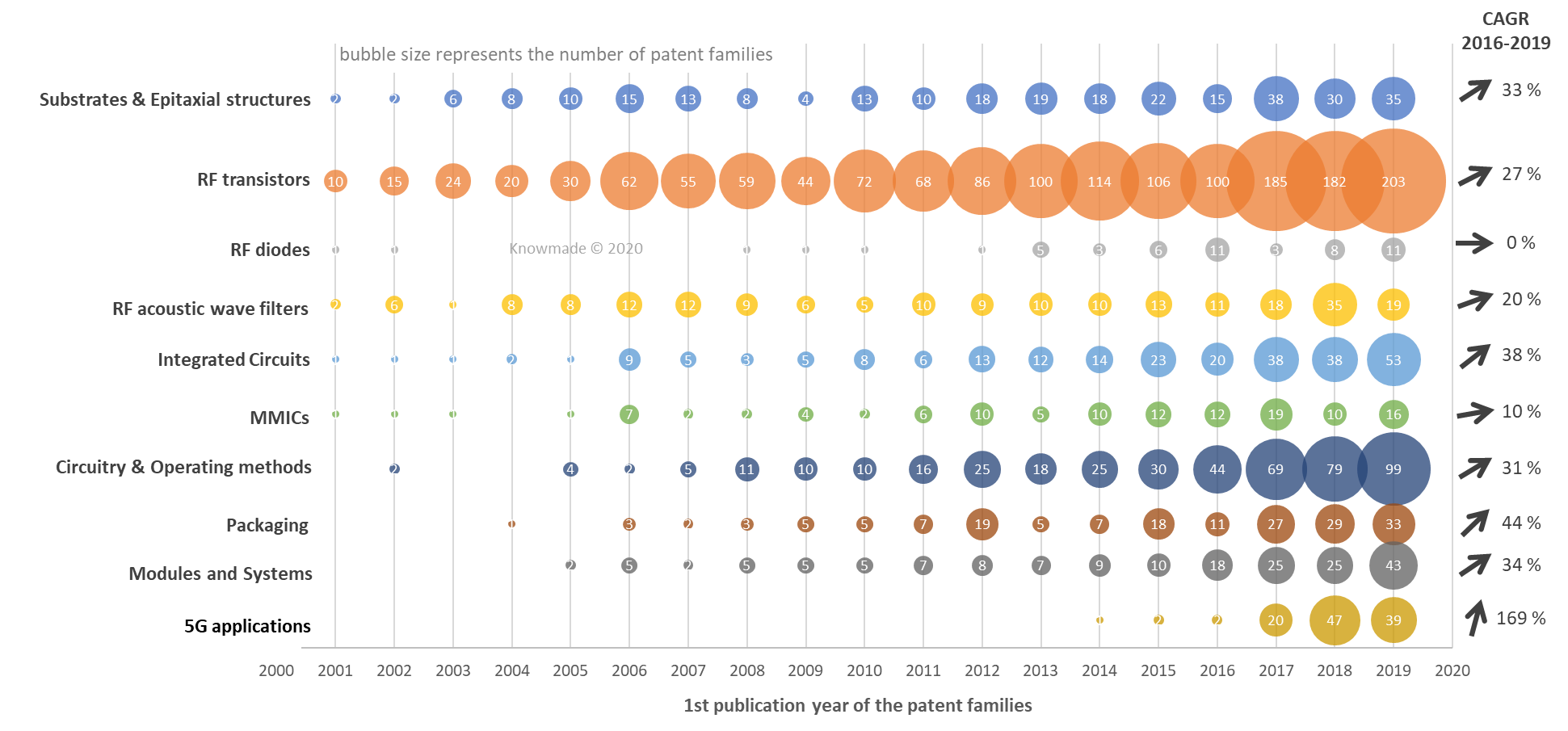SOPHIA ANTIPOLIS, France – November 6, 2020 | The radio frequency (RF) GaN market is experiencing impressive growth, mainly driven by telecom and military applications. Yole Développement predicts a GaN RF market increase from $740 million in 2019 to more than $2 billion in 2025, with a CAGR of 12%. According to market analysts, both the COVID-19 outbreak and the US-China conflict have started to change the landscape of the semiconductor industry. However, the virus outbreak is likely to have minor consequences for GaN deployment. Leading Chinese telecom operators’ 5G construction goals remain unchanged and development continues. Furthermore, the US-China conflict is likely to have a positive impact on Asian IDMs and foundries, as well as European players.
In this context, Knowmade is releasing a new RF GaN patent landscape report on November 6, 2020, covering the whole value chain from epitaxial structures to RF semiconductor devices, circuits, packages, modules and systems. Knowmade’s analysts have selected and analyzed more than 6,300 patents, representing more than 3,000 patent families (inventions) filed by more than 500 different organizations. “This 2020 edition comprises 2x more patent families and more than 100 new players compared to the 2019 edition”, says Nicolas Baron, CEO and Co-founder of Knowmade.
In this report, IP analysts give a comprehensive picture of the RF GaN competition and technology developments from a patent perspective.
– What are the IP dynamics and key trends for patents filings, companies, countries and technology?
– Who are the IP leaders, most active players and newcomers?
– Who are the new players or companies that are currently under the radar?
– What is the IP portfolio strength of the key players, and their technology/application focus?
– What is the status of RF GaN patented technologies, and the trends for each technology/application?
– What strategic and technological paths are leading companies and newcomers following for RF GaN technologies?

Figure 1: Ranking of patent applicants according to the number of their RF GaN-related patent families.
The first RF GaN patent applications were filed in the 1990s. The level of activity took off in 2004 and accelerated significantly from 2015. Today, the IP dynamics are driven by two major factors: (1) China, and (2) the shift of IP further down the value chain.
Chinese patenting activity has been accelerating since 2015. Over the last 2 years, we witnessed a remarkable increase in patents coming from China and many Chinese newcomers entering the RF GaN IP landscape. In 2019-2020, the Chinese organizations represented more than 40% of the patent applicants (Americans = 23%, Japanese = 10%, Europeans = 3%). “The rise in RF GaN patents from Chinese companies follows a more general trend as the country transitions from a manufacturing to an innovation-driven economy”, says Nicolas Baron. “This trend also reflects the situation in the RF industry, with a Chinese market that shows exploding demand for commercial wireless telecom applications and Chinese companies already developing next-gen telecom networks. Moreover, following the US-China trade war, numerous China-based companies are trying to develop GaN RF for 5G infrastructures internally”, he adds.
The RF GaN patent landscape is currently dominated by American and Japanese companies such as Cree, Fujitsu, Sumitomo Electric, Mitsubishi Electric, Intel, MACOM, Toshiba, Qorvo and Raytheon. The IP competition has been stronger in the US, as demonstrated by a much higher number of granted patents (1,200+) in contrast with China (640+), Japan (440+) and Europe (250+). However, the patenting activity is now focused on China.
Cree has the stronger IP position thanks to numerous fundamental patents, especially for GaN-on-SiC technology. Over the past 5 years, inventive activity at Cree, Sumitomo Electric and Toshiba stalled. These IP leaders have developed broad patent portfolios covering a wide range of RF GaN technology nodes. “The reduced IP activity could be a sign of confidence in their already robust RF GaN patent portfolio”, comments Nicolas Baron.
Intel and MACOM have strongly increased their IP activity since 2017, especially for GaN-on-Silicon technology. Intel is currently the most active patent applicant in the RF GaN field, with a record-high level of activity of patenting new inventions over the last couple of years which could, down the road, position it ahead of Sumitomo Electric, Fujitsu or Cree in terms of IP leadership.

Figure 2: IP leadership of RF GaN patent applicants.
In China, CETC and Xidian University have the most prolific inventive activity. Other players such as HiWafer, Dynax, Hanhua and China’s top public research entities UEST, IMECAS, SCUT and Institute of Semiconductors have built sizeable RF GaN IP portfolios, and numerous new players are entering the IP landscape (Boxin, Reactor Microelectronics, TUS – Semiconductor, Hatchip, Nexgo, Bosemi, HC Semitek, A-INFO, RDW, Chippacking, China Mobile, Gaxtrem, etc.). “The China IP rise should be taken seriously as it changes the landscape in which international companies operate”, says Nicolas Baron. While China currently emphasizes quantity over quality, many RF GaN patents from top Chinese organizations are up to international quality standards (CETC, Xidian University, HiWafer, Dynax, etc.). Furthermore, some Chinese companies which have global ambitions are filing or acquiring patents in key countries (Dynax, Hanhua, Zhuhai Crystal Resonance, ZTE, Huawei, CCT, Nexgo). Foreign companies are also now increasingly applying for patent protection in China (Mitsubishi Electric, NXP). For domestic or foreign businesses operating in China, this increases the risk of patent infringement which also becomes hard to manage.
European RF players Thales, BAE Systems, Infineon, Ampleon, Ericsson, etc. are only playing a small part in the current RF GaN IP dynamics. In Taiwan, the foundries Win Semiconductors, TSMC and GlobalWafers entered the RF GaN IP landscape first in the mid-2010s, followed by others such as VIS and Wavetek in 2018. South Korean entities are not very active in terms of patent filings. ETRI continued to file few new patents every year over the past decade. In 2016, RFHIC acquired GaN-on-Diamond-related patents from Element Six, then we observed the entry of Wavice, U-Tel and Wavepia more recently.
Over the last few years, the level of creativity to address all the technology and manufacturing roadblocks for GaN RF devices has been impressive. “More recently, IP developments are accelerating on topics further down the value chain to address manufacturing and technology issues related to monolithic integration, packaging, RF circuits and modules/systems. This trend is expected to accelerate as more mature RF products implement GaN technology”, affirms Nicolas Baron. The current patenting activity suggests that manufacturing and technology issues still need to be solved in monolithic integration of different RF semiconductor devices; thermal management at epi-stack, semiconductor device and package levels; linearity at semiconductor device and circuit levels; and protection, matching and distortion compensation at circuit level.
In this 2020 edition, Knowmade’s analysts detail the RF GaN IP landscape and recent patents of note related to GaN-on-SiC, GaN-on-Silicon, GaN-on-Diamond and GaN-on-Sapphire. They analyze and describe the IP activity related to RF transistors (HEMT, HBT, E-mode, etc.), RF diodes (varactor, RTD, IMPATT, etc.), and RF acoustic wave devices (SAW, TC-SAW, FBAR, BAW-SMR). Furthermore, the report includes a section dedicated to GaN-based MMIC related patents. Overall, IP analysts highlight patents dealing with manufacturing and technology issues still of interest to IP players (heat dissipation, monolithic integration, linearity, impedance matching, etc.), and/or targeting MW/mmWave frequency ranges or 5G telecom applications.

Figure 3: Time evolution of RF GaN-related patent publications for main segments.
GaN-related patenting activity is prolific; more and more players are entering the playground and the GaN IP landscape is evolving. On the one hand, some GaN startups and pure-play companies remain on the lookout for promising business opportunities and are developing transversal GaN IP portfolios to address not only RF applications but also power electronics. On the other hand, RF companies from outside the GaN industry, and OEMs, are seeking to take leading positions on RF GaN by developing patents claiming the use of GaN technology in RF modules/systems. There are now enough companies with transversal portfolios, and enough enforceable patents worldwide which address most technology issues in the whole value chain, to say that the freedom-to-operate of practicing entities is shrinking, and to predict that complex licensing and legal battles will likely arise once GaN RF devices enter the high-volume commercial markets. Now the questions are: will Chinese IP shape the future of the GaN RF industry? And which IP owners will be the GaN RF leaders in the 5G, post-COVID world?
Knowmade is releasing this new RF GaN patent landscape report to offer a complementary overview of the RF GaN competitive landscape and its evolution through patenting activity. In this report, Knowmade’s analysts give deep insights on the IP portfolios and strategies of key RF GaN players and newcomers, and highlight the strategic and technological paths they are following for RF GaN technologies. All year long, Knowmade’s team has been investigating both GaN and RF-related patenting activities to get a deep understanding of the technology and intellectual property evolution, and their potential business impact. This 2020 edition is part of a collection of GaN and RF analyses including GaN-on-Silicon Patent Landscape 2020, Power GaN Patent Landscape 2019, and RF Acoustic Wave Filters Patent Landscape 2019. RF GaN patents and technologies are also tracked and analyzed in the GaN Power & RF Patent Monitor and RF Acoustic Wave Filters Patent Monitor.
KnowMade’s RF and Wireless communication technology patent reports.
Press contact
contact@knowmade.fr
Le Drakkar, 2405 route des Dolines, 06560 Valbonne Sophia Antipolis, France
www.knowmade.com
About the author
Nicolas Baron, PhD. Nicolas is CEO and co-founder of Knowmade. He manages the development and strategic orientation of the company and personally leads the semiconductor department. He holds a PhD in Physics from the University of Nice Sophia-Antipolis, and a Master of Intellectual Property Strategies and Innovation from the European Institute for Enterprise and Intellectual Property (IEEPI), Strasbourg, France.
About Knowmade
Knowmade is a Technology Intelligence and IP Strategy consulting company specialized in analysis of patents and scientific information. The company helps innovative companies and R&D organizations to understand their competitive landscape, follow technology trends, and find out opportunities and threats in terms of technology and patents.
Knowmade’s analysts combine their strong technology expertise and in-depth knowledge of patents with powerful analytics tools and methodologies to turn patents and scientific information into business-oriented report for decision makers working in R&D, Innovation Strategy, Intellectual Property, and Marketing. Our experts provide prior art search, patent landscape analysis, scientific literature analysis, patent valuation, IP due diligence and freedom-to-operate analysis. In parallel the company proposes litigation/licensing support, technology scouting and IP/technology watch service.
Knowmade has a solid expertise in Compound Semiconductors, Power Electronics, Batteries, RF Technologies & Wireless Communications, Solid-State Lighting & Display, Photonics, Memories, MEMS & Solid-State Sensors/Actuators, Semiconductor Manufacturing, Packaging & Assembly, Medical Devices, Medical Imaging, Microfluidics, Biotechnology, Pharmaceutics, and Agri-Food.
